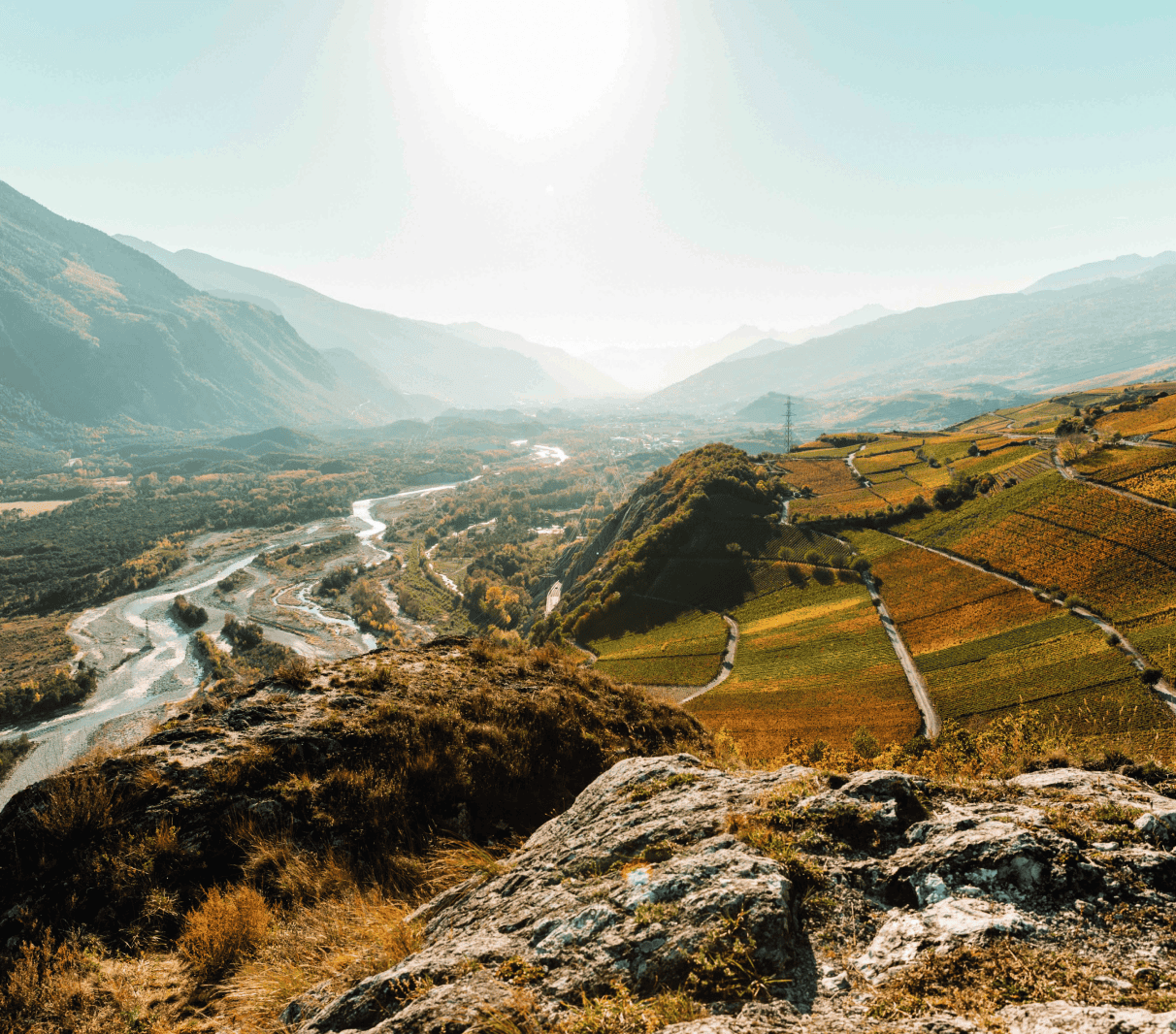Vineyards
The vineyards of the Diego Mathier family
Over the years, around 45 hectares of outstanding cru vineyards have come into the Mathier family’s possession. Viticulture has evolved with the times. Even though technology has made it easier nowadays, the vineyard work still requires a lot of manual labor.
Terroir
Perfect climatic conditions for top wines
In the Valais Rhone Valley from Turtmann to Chamoson, we find perfect conditions for growing first-class red and white wine.
Hectares of cru sites
average precipitation per m2
"On the one hand, we are of course favored by the climatic conditions that the Rhone Valley provides us with the river as the mother of all vegetation in the valley floor and the constantly prevailing, light Föhn wind"
Diego Mathier
Vineyards
Best vineyards in Valais
Discover a selection of our vineyards between Turtmann and Chamoson
Domaine de l'Ambassadeur
Pinot Noir de Salquenen
Wyler Molignon
Chasselas

Steep slopes of Turtmann
Heida
"Vitiswiss (Swiss Association for Sustainable Development in Viticulture), which has set itself the goal of producing healthy grapes, preserving landscapes and biodiversity as well as conserving and promoting natural resources and energy, among other things, has consistently awarded us the highest accolade for our activities for years."
Diego Mathier

Valais Rhone Valley
The Rhone - the mother of viticulture in Valais
The Rhone Glacier, which decisively shaped the valley with its last glacial advance (115,000 to 15,000 years ago), apparently meant well for the winegrowers of modern times. From moraine deposits near Chamoson and extremely slatey soils to humus-rich and clayey soils or calcareous subsoils, there is an almost paradisiacal diversity that makes Diego Mathier rejoice. “Our valuable heritage of Grand Cru vineyards paired with this almost paradisiacal variety of soil conditions, which is unparalleled in Switzerland, allows us to play with the grape varieties in a positive sense and with the aim of creating the perfect moment of pleasure in the wine glass. In addition, we are able to divide Valais into two climatic regions and align our cultivation strategy accordingly. From the Upper Valais to Chamoson, for example, there is very little precipitation, while we find that from Leytron to Martigny there is much more rainfall in comparison.”
How we combine grape varieties to suit the respective terroirs
Salgesch
Salgesch and its characteristic landscape with around 50 hills between Leuk and Sierre was formed around 13,000 years ago thanks to one of the largest landslides in the Alps. In this event, no less than one cubic kilometer of rock broke loose below the Varenalpe and thundered down into the valley. The result is exceptionally calcareous soils on which red wine in particular (85% of the area under cultivation is devoted to red wine), especially Pinot Noir (70% of the red wine vines are devoted to Pinot Noir alone), Gamay and Cornalin thrive. This is one of the reasons why Salgesch is known as the Pinot Noir Mecca of Switzerland.
Sierre
Sierre offers a mixture of very humus-rich soils and very hard soils and, in combination with the strong sunshine in this region, is predestined for the cultivation of Chasselas. The successful winegrower Diego Mathier mainly cultivates the grapes for his Fendant du Ravin or the Ville de Sierre here.
Wiler Molignon
The Wiler Molignon has slate soils, which provide a beautiful minerality in the wines. Ideal conditions for the Fendant Molignon from the Terre Promise line or, thanks to the elevated location, for the Petite Arvine Les Pyramides, which has already received numerous top international awards, not least due to this combination of grape varieties and terroir.
Sion
Around Sion, the capital of the canton of Valais, there are also excellent slate soils that lend the wines an elegant minerality and are therefore extremely well suited to the cultivation of white wine grape varieties. The grapes for the Fendant Ville de Sion and also for the dessert wine Ermitage Rubin (near Leytron) thrive here. And in the place called La Folie, Pinot Noir vines over 100 years old thrive, the grapes of which are refined into Pinot Noir La Folie.
Turtmann
Turtmann, located to the east of Salgesch, has very clayey, i.e. impermeable soils. Savagnin blanc grapes are preferably grown on this terroir, which then taste good in the glass as Heida.
Vétroz
The municipality of Vétroz is home to black slate soils, which serve as the basis for growing the grapes from which the best Swiss winegrower of the decade produces the Amigne de Vétroz.
Chamoson
Chamoson, with its moraine deposits and pebbly soils, offers ideal conditions for the Johannisberg Weidmannstrunk and Ambassadeur Fumé Gros Rhin grapes. The pebble soils act as a double source of thermal energy. While they store the heat from the sun during the day and release it to the plant overnight, they reflect the sunlight during the day, which then also falls on the plant and its grape vines from below, so to speak.
Conthey
Conthey, located behind Sion from Salgesch, is a growing area that is ideal for late-ripening grape varieties, as the hottest sites in Valais can be found here. The successful winegrower from Salgesch prefers to plant the grapes for his Syrah Diego Mathier here.
Subscribe to our newsletter & benefit
Subscribe to our newsletter and benefit from interesting offers.
By clicking on Register you confirm that you accept our TERMS AND CONDITIONS accept.
Do you have any questions?
If you have any questions or inquiries, please do not hesitate to contact us.
Send us an e-mail and we will get back to you as soon as possible.
Telephone
Give us a call and speak directly to one of our employees.